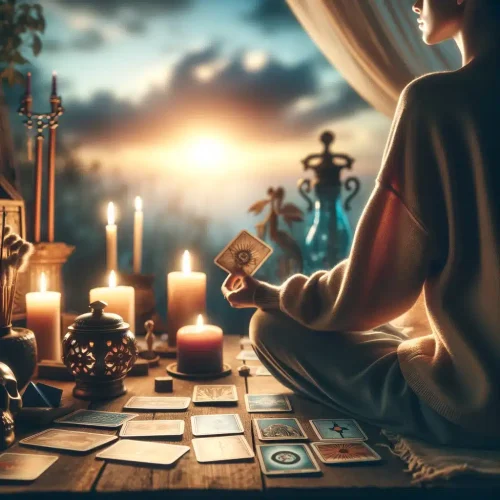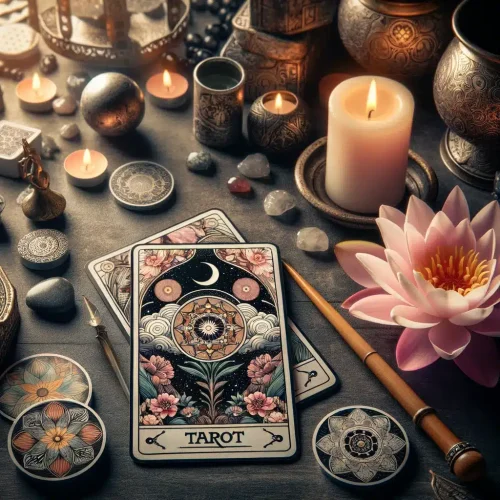Tarot and Spirituality

From Mysticism to Insight
The captivating world of tarot cards is not just a collection of beautiful images and symbols. Their origins and evolution are deeply rooted in spirituality and mysticism, making them more than mere tools for divination. In this article, we explore the fascinating history of tarot cards and their connection to spiritual traditions.
The Origins of Tarot Cards
The exact origins of tarot cards are shrouded in mystery. Some historians claim they first appeared in Europe in the 15th century, introduced by traveling Romani people. Other theories suggest that tarot may have roots in older cultures and traditions, perhaps as a form of Egyptian mysticism or as an evolution of Islamic playing cards.
Regardless of their origins, tarot cards quickly became popular in Europe. They were initially used as playing cards, but their deep symbolism and intricate images led them to eventually be associated with more esoteric and spiritual uses.
Tarot Cards in Different Cultures
Throughout history, different cultures have adapted and used tarot cards in many unique ways. In Renaissance Italy, tarot cards were associated with the aristocracy and used in complex card games. Over time, they began to be seen as a medium for divination and reflection, thus being increasingly linked to spiritual and mystical practices.
In France during the 18th century, tarot cards began to be used for esoteric purposes. It was then that concepts such as tarot divination and symbolic interpretation seemed to take hold. French occultists like Antoine Court de Gébelin and Jean-Baptiste Alliette (also known as Etteilla) played significant roles in developing and spreading ideas about tarot as a spiritual and mystical tool.
In the 20th century, as interest in occultism and mysticism grew, various spiritual and esoteric movements, such as the New Age movement, incorporated tarot into their practices. The rich symbolism and potential for self-reflection made tarot a popular tool for spiritual exploration and personal growth.
Tarot in Contemporary Spiritual Practices
Today, tarot cards are an integrated part of many people’s spiritual lives. They are not only used to predict the future but also as a powerful tool for self-knowledge, meditation, and reflection. Many modern tarot readers emphasize the cards’ role in providing insight and guidance rather than predicting specific events.
In various spiritual contexts, tarot cards are often used to explore the subconscious, identify inner conflicts, and promote self-understanding. They are seen as a mirror for the soul, reflecting our deepest feelings, fears, desires, and spiritual aspirations.
Practical Tips for Integrating Tarot into Your Spiritual Routine
Integrating tarot into your spiritual practice can be an enriching and enlightening experience. Here is a step-by-step guide for beginners that covers everything from choosing a tarot deck to using the cards in a meaningful way.
Choosing a Tarot Deck
- Research and Intuition: Start by exploring different types of tarot decks. Each deck has its own unique style and symbolism. Let your intuition guide you to a deck that resonates with you.
- Understanding the Traditions: There are traditional decks like the Rider-Waite-Smith or Tarot de Marseille, as well as modern decks with varying themes and artistic expressions. Choose a deck that speaks to you both visually and spiritually.
Cleansing and Charging the Cards
- Cleansing: Once you have your deck, begin by cleansing it. This can be done by lightly tapping the deck, smudging it with sage, or placing it in the moonlight. Cleansing removes all previous energy so you can start with a clean deck.
- Charging and Intention: Then, sit with your deck and focus on your intention with it. It could be seeking guidance, self-reflection, or spiritual growth. Visualize your energy flowing into the cards.
Learning Basic Spreads
- Daily One-Card Draw: Start by drawing one card every day. This provides a chance to reflect on the day ahead and how the card’s message might be relevant.
- Three-Card Spread: This spread involves cards for the past, present, and future. It’s a good method for getting an overview of your spiritual journey or a specific situation.
- Celtic Cross Spread: For a more detailed reading, consider the Celtic Cross spread that provides insight into different aspects of a question or challenge.
Integrating Tarot into Your Daily Practice
- Meditation and Reflection: Use tarot cards as a focus for meditation. Contemplate the imagery and messages of the cards and how it relates to your inner journey.
- Journaling: Write down your thoughts and insights from your daily card draws or spreads. This helps you track your spiritual development over time.
- Combine with Other Practices: If you practice yoga, mindfulness, or other spiritual exercises, consider integrating tarot as part of these routines to create a more holistic practice.
Tarot Meditation

Tarot cards have long been a tool for divination and self-reflection, but they can also play a central role in a deeper spiritual practice. By using tarot cards as a focus in meditation, one can explore their inner landscape and increase their spiritual awareness. In this article, we explore various techniques for using tarot in meditation and share case studies that show how this practice can deepen spiritual insight.
Tarot Meditation Techniques
1. Choosing the Right Card
Choose a card that you feel drawn to, or let the universe decide by drawing a card at random. The card you choose becomes the focus of your meditation.
2. Creating a Meditation Space
Prepare your meditation space. You may choose to light candles, burn incense, or anything else that helps you create a meditative and relaxing atmosphere.
3. Focusing on the Image
Sit comfortably and hold the card in front of you. Let your eyes focus on the details, colors, and symbols of the card. Observe what you feel and think as you look at the card.
4. Diving Deep into the Symbolism
Let your gaze rest on a specific part of the card. Imagine stepping into the world of the card and interacting with its figures and symbols. What do they say to you?
5. Reflecting and Journaling
After your meditation, reflect on your experience and write down your thoughts. What did the card reveal? Were there any surprising insights?
Case Studies of Tarot Meditation
Case Study 1: Self-Discovery through the Death Card
One person chose to meditate on the Death card, often misunderstood as a negative sign. Through meditation, they realized the card represented a necessary change and an opportunity for renewal. This led them to make significant life changes and embrace new opportunities.
Case Study 2: Strength and Self-Confidence through the Empress Card
Another individual used the Empress card as the focus for their meditation. By exploring the card’s energy of nurturing and creativity, they began to feel an increased sense of strength and self-confidence in their daily life.
Balancing Tarot and Spirituality
Tarot has long served as a bridge between the conscious and the subconscious, offering guidance and insights on our spiritual journey. But it’s important to understand and respect the boundaries between tarot reading and personal spiritual beliefs. This balance is crucial for a healthy spiritual practice.
Understanding the Limits
Respecting Tarot’s Role
Tarot is a tool for insight and reflection, not an absolute truth. The cards should be seen as guides that can help illuminate various aspects of our life experience and inner world. They offer perspective, not definitive answers.
Spiritual Belief and Tarot
Your personal spiritual belief is the core of your spiritual identity. Tarot readings should not replace or dominate these beliefs. Instead, they should function complementarily, helping to enhance and enlighten your personal spiritual understanding.
Managing Dependency on Tarot
Independence in Spirituality
Spiritual practice is about finding your own path and understanding. Relying excessively on tarot readings for spiritual decisions can hinder this personal growth. It’s important to develop an inner sense of intuition and self-confidence in your spiritual journey.
Balancing Use
Include tarot in your spiritual practice in a balanced way. This may involve limiting the frequency of readings or being mindful of when you’re relying on the cards for answers that you should be finding within yourself.
Reflection and Personal Responsibility
Use the time after each reading to reflect. Ask yourself questions like: ”How can I use this insight in a constructive way?” or ”What does this say about my own inner wisdom?” Tarot is most powerful when it complements your own reflection and insight.

